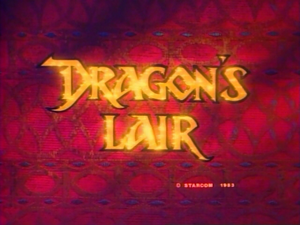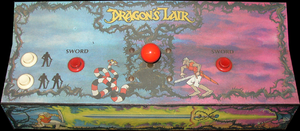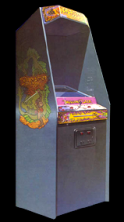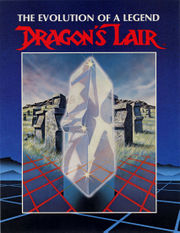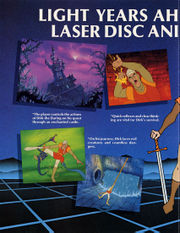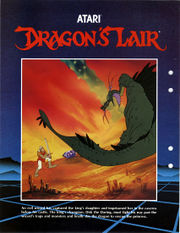Lost In Translation/Dragon's Lair
| Dragon's Lair | |
|---|---|
| Manufacturer | Cinematronics |
| Released | 1983 |
| Control Method |
8-way Joystick 1 Button(s) |
| Main CPU | Laserdisc Z80 (@ 4.000 MHz) |
| Sound CPU | Stereo AY-3-8910A (@ 2.000 MHz) Custom |
| Video Details |
Raster (Horizontal) 256 x 256 pixels 59.94 Hz Palette colours |
| Screens | 1 |
| ROM Info | 4 ROMs plus Laserdisc, Hard Disk or CD-ROM 32,768 bytes (32.00 KiB) |
| MAME ID | dlair · dlairf · dlaire · dlaird · dlairc · dlairb · dlaira · dleuro · dlital |
About The Game
Dragon's Lair is THE original Laserdisc video arcade game, the video and sound sequences for the game are stored on a Laserdisc. This unprecedented game lets a player participate in an animated and interactive motion-picture experience.
Dragon's Lair is the first game born to the new generation of video games. This unprecedented game is the first motion-picture type fairy tale you interact with.
As Dirk the Daring, a player's goal is to rescue the princess. The adventures along the way are horrible and terrifying, but, a skilled and brave knight, like honor and truth, can prevail.
A player has a choice of 5 moves at any given time. A complete game of Dragon's Lair requires more than 200 correct moves. Timing is critical! Dirk can't be too hesitant or too eager to make a move. Only experience and a good memory enable Dirk to complete his mission.
The game opens with the dark visage of a foreboding castle looming in the distance. The next thing you know, you are Dirk, running across the castle drawbridge. The gate clangs shut behind you, and your quest to kill the dragon and save Princess Daphne has begun!
More than 40 possible episodes will be presented to you. Some require many fast repeated moves; others will require fewer, more calculated moves.
Dragon's Lair can be a 1-or 2-player game. If 2 play, 2 twin knights engage in mortal combat with the same demons until they both die (use up their lives), or until one rescues the fair princess from the dragon's lair.
At the beginning of the game, if the player makes a wrong move and loses a life, a new scene will appear at random. Later in the game, a scene that is not completed properly is repeated until it is mastered. Also, when a player loses a life, the scene stops, the screen turns blue, and PLAYER 1 or PLAYER 2 is displayed on the screen, along with that player's number of remaining lives.
As you play the game you may find that some scenes are repeated, but the image is reversed on the screen (the scene is reversed on the disc, not by the hardware).
Princess Daphne appears during the game, in distress and crying for help. She is unattainable until the end.
Additional Technical Information
The images for the game are stored on a Laserdisc, a type of storage device. Dragon's Lair uses a Laserdisc player made by Philips (model 22VP 932/00) and a Z80 microprocessor to generate the images and action required for game play.
Most of the sounds you hear during game play originate from the disc.
The control panel :
SWORD BUTTONS : Causes Dirk to draw and use his sword.
JOYSTICK : Controls Dirk's movements. Dirk moves in the direction that the joystick is pointed. In some instances, moving Dirk to an object causes him to do something with that object.
Trivia
Released in June 1983.
Licensed to Atari for European distribution and to Sidam for Italian distribution.
The attract mode of the game displays various short vignettes of gameplay with the accompanying narration : 'Dragon's Lair: The fantasy adventure where you become a valiant knight, on a quest to rescue the fair princess from the clutches of an evil dragon. You control the actions of a daring adventurer, finding his way through the castle of a dark wizard, who has enchanted it with treacherous monsters and obstacles. In the mysterious caverns below the castle, your odyssey continues against the awesome forces that oppose your efforts to reach the Dragon's Lair. Lead on, adventurer. Your quest awaits!'
Dragon's Lair was the first game to use the then-new Laserdisc format. It was the first game to have feature-quality animation (exactly 22 minutes of full animation at a cost of 1.3 million dollars). This set it apart from the other arcade games of the day which had very primitive graphics.
The animation was done by Don Bluth Studios, which also did feature-length animated movies such as 'The Secret of NIMH' and 'An American Tail'. Don Bluth was a former Disney employee who left to start his own company. To keep the cost as low as possible, they decided not to hire professional voice actors. Instead they all pitched in and did the voices themselves. Sound Engineer, Dan Molina was the voice of Dirk the Daring. Vera Lanpher, head of assistant animators, was the voice of Daphne. The narrator was Michael Rye and the musical score was created by Christopher Stone.
Dirk only speaks twice. Once, he mutters 'Uh, oh' when the platform begins to recede during the fire-swinging sequence, and exclaims 'Wow!' when first entering the dragon's lair.
Dragon's Lair had a huge impact on the arcade industry in 1983 (grossing more than 32 million dollars in the first eight months in the arcades). It was so big that quite a bit of merchandise was produced. Dragon's Lair books, buttons, trading cards, stickers and toys were just a few of the many different items that could be purchased.
Marvel Studio produced a Saturday-morning TV-show based on the game. The TV show, produced by Ruby Spears, debuted in the fall of 1984 on ABC and lasted only 1 season.
There was also a Dragon's Lair feature film that was planned, storyboarded, and written but never put into production. The film was to be called 'Dragon's Lair - The Legend'.
KOTO, an Italian synth group released two Discs in 1988, KOTO 'Dragons Legend' and KOTO 'Dragons Megamix'. The remix music themes include takes of the audio from the attract mode of Dragon's Lairas well as some dialogs of Daphne in game. The themes are Dragons Legend, Dragons Legend (Dub version) and Dragons Megamix.
A Dragon's Lair machine was shown at the 2003 classic arcade games show 'California Extreme' in San Jose, California.
Updates
- Rev. A : use the Pioneer PR-7820 only, 5 Chip set.
- Rev. B : use the Pioneer PR-7820 only, 5 Chip set.
- Rev. C : use the Pioneer PR-7820 only, 5 Chip set.
- Rev. D : use the Pioneer PR-7820 only, 5 Chip set.
- Rev. E : use the Pioneer LD-V1000 only, 4 Chip set.
- Rev. F : use either players, 4 Chip set.
- Rev. F2 : use either players, 4 Chip set.
Scoring
Because the monsters and traps to be overcome are so numerous and constantly changing, it is not possible to list the range of scores awarded for each one.
Tips and tricks
Hints
- React! Often the player will be given a visual cue as to which direction to move. These cues are often presented as a flashing light, flashing tunnel, flashing rope, or flashing door. In general, the player should move toward a flashing object.
- Remember, even though the player may know the direction to move, the timing of his move is critical.
- The player must react to fire -- it is his enemy. He should not linger too long near fire, and in general, he should move away from blazing fires.
Unlimited Lives
On some versions of Dragon's Lair the programmers left a secret Easter Egg that allows you to have unlimited lives. To access it, wait for the Attract Mode to begin, then hold the joystick UPLEFT and press the Sword button while inserting your quarters. Release the joystick and then select 1 player. You will now have unlimited lives until you complete the game.
Series
- Dragon's Lair (1983)
- Dragon's Lair II - Time Warp (1991)
- Dragon's Lair 3D - Return To The Lair (2002, PC CD-ROM)
- Dragon's Lair 3 (2004, PC CD-ROM)
Staff
- Animation By
- Don Bluth
- Gameplay Designed By
- Victor Penman
- Marty Foulger
- Darlene Waddington
- Programmed By
- Mike Knauer
- Vince Lee
Cabinet and Artwork
Ports


- Consoles
- Colecovision (1984)
- Nintendo Famicom (1990)
- Nintendo Game Boy (1990)
- Nintendo SNES (1992)
- Panasonic 3DO (1994)
- Sega Mega-CD (1993)
- Phillips CD-I (1994)
- Atari Jaguar [CD] (1995)
- Nintendo Game Boy Color (2000)
- Sony PlayStation 2 (2000)
- Microsoft XBOX (2001)
- Computers
- Commodore C64 (1986, "Dragon's Lair" / 1987, "Dragon's Lair II")
- Sinclair ZX Spectrum (1986, "Dragon's Lair" / 1987, "Dragon's Lair II")
- Amstrad CPC (1986, "Dragon's Lair" / 1987, "Dragon's Lair II")
- Commodore Amiga ("Dragon's Lair", 1988, ReadySoft)
- Commodore Amiga ("Dragon's Lair: Escape From Singe’s Castle", 1989, ReadySoft)
- Atari ST [1988)
- Apple Macintosh [3.5"] (1988)
- PC [MS-DOS, 3.5" / 5.25"] (1990, "Dragon's Lair")
- PC [MS-DOS, 3.5" / 5.25"] (1991, "Dragon's Lair - Escape from Singe's Castle")
- PC [MS Windows 9x, DVD-ROM] (1997)
- PC [MS Windows 9x, CD-ROM] (1997, "Dragon's Lair Deluxe Pack")
- PC [MS Windows, CD-ROM] (2001, "Arcade Authentic Version")
- Others
- DVD-Video (1998)
- DVD-Video [PS2 & XBOX Compatible] (2002, "Dragon's Lair 20th Anniversary Special Edition")
External Links
- Sinclair ZX Spectrum version of Dragon's Lair at the World of Spectrum
- Sinclair ZX Spectrum version of Dragon's Lair II: Escape from Singe's Castle at the World of Spectrum


